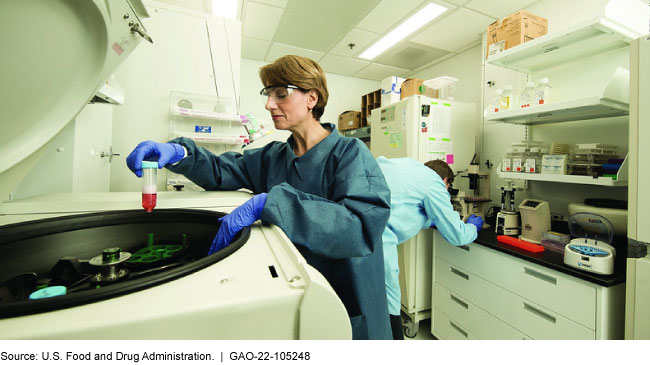Public Health Preparedness: Medical Countermeasure Development for Certain Serious or Life-Threatening Conditions
Fast Facts
Past bioterrorist attacks, such as the anthrax attacks of 2001, highlight the threats posed by chemical, biological, radiological, and nuclear agents—and the importance of medical countermeasures to treat people in the aftermath.
FDA established the Animal Rule in 2002 to allow for the approval of medical countermeasures based on animal studies when human clinical trials are not ethical or feasible.
We found that FDA has provided guidance to support development of medical countermeasures under the rule, such as by clarifying the types of data needed to demonstrate product efficacy.
FDA has approved 16 medical countermeasures under this rule.
FDA Human Clinical Trials

Highlights
What GAO Found
The Department of Health and Human Services' (HHS) Food and Drug Administration (FDA) established the Animal Rule in 2002 to allow for the approval of medical countermeasures based on animal efficacy studies when human clinical trials are not ethical or feasible. Medical countermeasures are medical products that may be used to prevent, treat, or mitigate potential health effects of exposure to chemical, biological, radiological, and nuclear (CBRN) agents. GAO found that FDA has undertaken efforts to provide information and feedback to developers to support medical countermeasure development under the Animal Rule. For example, in 2015 FDA issued guidance clarifying the types of studies and data needed to demonstrate product efficacy. FDA has approved 16 medical countermeasures under the Animal Rule, 14 of which were approved over the past decade.
Research of Biological Agents in a Clinical Laboratory

FDA established the Animal Model Qualification Program in 2011 to provide publicly available animal models to support efficacy testing under the Animal Rule for multiple medical countermeasures for a given disease or condition. Researchers and developers can submit models to the program for qualification, and, once qualified, a model can be used by other developers when appropriate. For example, an animal model for inhalation anthrax would include protocols, such as exposure timing and dosage, to produce disease manifestations that adequately reflect inhalation anthrax manifestations in humans. As of April 2022, FDA has qualified one animal model under the program. FDA officials and many developers GAO spoke with attributed the limited number of qualified models to a lack of an incentive to pursue qualification. Specifically, submitting a model for qualification is voluntary, and FDA officials said the qualification process is rigorous and resource intensive, which may deter submissions. However, many developers reported that the limited number of qualified animal models has not impeded product development, citing other ways to identify animal models that can be used for product development. FDA officials and others that GAO spoke with, including some developers and contract research organizations, said the program may still be beneficial. For example, FDA officials said the program could help further future development of medical countermeasures, particularly for CBRN agents that currently do not have approved medical countermeasures.
Why GAO Did This Study
Past bioterrorist attacks, such as the anthrax attacks of 2001, highlight the threat of widespread illness and death posed by CBRN agents and the importance of medical countermeasures. GAO has previously reported on the challenges of developing medical countermeasures. Medical countermeasures may need to be developed and approved under FDA's Animal Rule.
The Pandemic and All-Hazards Preparedness and Advancing Innovation Act of 2019 included a provision for GAO to review medical countermeasure development under the Animal Rule. In this report GAO describes (1) FDA efforts to support medical countermeasure developers under the Animal Rule, and (2) the extent of animal model qualification under FDA's Animal Model Qualification Program, and the effect of qualified models on medical countermeasure development.
GAO reviewed FDA documentation, including agency medical countermeasure development guidance. GAO also interviewed or obtained written responses from FDA officials; other federal agencies involved in medical countermeasure development; and a nongeneralizable selection of six developers, three contract research organizations and four academic research and policy organizations. GAO selected interviewees based on their involvement in or knowledge of medical countermeasure development under the Animal Rule.
HHS and the Department of Defense provided technical comments, which GAO incorporated as appropriate.
For more information, contact Mary Denigan-Macauley at (202) 512-7114 or DeniganMacauleyM@gao.gov.
